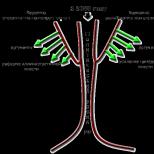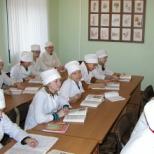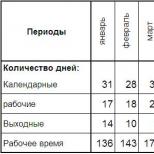Bolshoy Dmitrovka 7 5. House of the Glebov-Streshnevs
Hotel "Hostel Stay Inn" is located a stone's throw from the Cathedral of Christ the Savior and the Multimedia Art Museum. At a distance of 250 meters from the apartment is the metro station "Kropotkinskaya". Travelers who book the Stay Inn Hostel can take a 15-minute metro ride to Belorussky Train Station, from which the Aeroexpress electric train departs to Sheremetyevo International Airport. The Stay Inn Hostel is located next to the Zachatievsky Convent and the Zurab Tsereteli Art Gallery. A 5-minute walk from the apartments is Bolotny Island and the following attractions located on it: the monument "Children - victims of the vices of adults", Bolotnaya Square and the monument to Repin, the Variety Theater, the Museum of Local Lore "House on the Embankment". From Bolotny Island, you can quickly get to the State Tretyakov Gallery and the Church of St. Nicholas in Tolmachi. Booking the Stay Inn Hostel hotel will provide accommodation within a 10-minute walk from the Russian Academy of Arts, the Central House of Actor named after A.A. Yablochkina. Nearby are the Church of the Transfiguration of the Lord on the Sands, the Vakhtangov Theater and the Memorial Apartment of A.S. Pushkin. The price of visiting the expositions in this museum varies, depending on the type of ticket. It can be purchased as a single ticket, including viewing of all expositions, its price is from 250 to 350 rudders; as well as a family weekend ticket, costing 350 rubles, which also provides certain benefits. In the immediate vicinity of the apartments are the Memorial Museum-workshop of the sculptor A.S. Golubkina, the Moscow Palace of Youth, the Ministry of Foreign Affairs of the Russian Federation, the Trubetskoy Estate in Khamovniki park, Maiden's Field square with a monument to L.N. Tolstoy.
To see this house, you need to turn off the front door of Bolshaya Dmitrovka and go into the courtyard. A strange house: one of the three risalits seems to have been amputated by a not very skilled surgeon, a number of false windows, the facade facing Dmitrovka is rusted, but the rear facade is also distinguished by a monumental risalit in the center, as if the obverse and reverse had once changed places.
The designation of the development of this place can be found already in the 16th century, on Peter's drawing. And in the 17th century, the owner also appeared - the roundabout Rodion Matveevich Streshnev. From him the estate on Dmitrovka passed to his son, and then to his grandson. In 1734, the first reliable mention of the chambers appears, although, perhaps, the house is older. Some researchers believe that the vaulted rooms in the south wing belong to the 17th century volume.
In 1808 E. P. Glebova-Streshneva became the owner. Under her leadership, a plan for the classical composition of the estate is being developed, but they do not have time to implement it, the war interferes. The main house, by that time already three-story, actually stands in the center; two-story outbuildings with arched passages, which along Kamergersky, are rented out. One of them houses an arena, rare for private houses, rented for himself by Prince Kasatkin-Rostovsky. One of the buildings of the estate for a ladies' wear shop is rented by the merchant Dominik Sichler, to whom Natalya Nikolaevna Goncharova herself went to buy hats.
According to the project of 1811, it was supposed to build outbuildings from the north, symmetrical to the south, and move the main entrance from the lane to Dmitrovka. To do this, it was necessary to “unfold” the house, which until now stood back to the street (here are two facades). The idea was partially implemented in the 20s and 30s of the 19th century. At the same time, the main house itself, which burned down in 1812, was also restored. The work dragged on for almost ten years; the yard, so as not to be empty, was given under the tenant service. In the same troublesome "repair" time, Vladimir Alekseevich Musin-Pushkin lives in the house under police supervision for about a year.
As soon as the reconstruction is completed, the landlady moves in to the main house, and the estate is immediately freed from lodging. In 1854, the grandson of Elizabeth Petrovna, Fedor Petrovich, was engaged in the next reorganization (to correct finances). He makes a part of non-residential buildings residential, builds up arched driveways in order to increase the area; outbuildings along the alley with the same purpose partially builds on the third floor. Apartments with him are rented by Mikhail Vilgelmovich Richter - Doctor of Medicine, director of the obstetric institute, obstetrician, and historian, archaeologist and architect who participated in the restoration of the Kremlin churches and palaces.
Since 1862, one of the richest Moscow residents and the largest homeowners has become the owner. He rents out a new acquisition in part to the doctor of medicine N. V. Brusa (with the right to build) and in part to the merchant Gerasim Ivanovich Khludov, an honorary citizen and collector of paintings, mainly of the Russian school. The first builds on one of the houses in the yard with a photo gallery, the second is more interesting to those to whom he rents apartments.
On February 3, 1866, the Tolstoy family moved into the house. They considered it necessary to rent a separate apartment for the period of their stay in Moscow. Sofya Andreevna writes in her diary: “All my life went well, I loved everything in Moscow, even our Dmitrovka and our stuffy living room-bedroom and study, where Leva sculpted his red horse and where they used to sit together in the evenings.” Nearby is the Chevalier hotel, beloved by the writer, along the lanes you can walk to the gymnasium of Jacob Poiret. On this trip, Tolstoy met Mikhail Bashilov, a relative of the Berses, an artist who illustrated Griboyedov's Woe from Wit. Katkov also comes here to persuade Tolstoy to submit the next part of "1805" (to be included in "War and Peace") to the Russky Vestnik for publication. Lev Nikolaevich agrees. And on February 27, he reads here the chapters of the future novel "War and Peace" to the assembled admirers.
In October 1867, the poet Fyodor Ivanovich Tyutchev visited his relatives. His daughter's family rents an apartment here, but the visit is connected with Anna's unsuccessful birth. Ivan Sergeevich Aksakov, husband of Anna Fedorovna, publicist, public figure, publisher at that time publishes the Slavophil newspaper Moskva, the editorial office is located right in the apartment.
In 1883, another edition appeared in the house - the satirical magazine "Alarm Clock". This is a weekly publication with two thousand subscribers, for which I. I. Dmitriev, F. M. Reshetnikov, M. M. Stepanovsky, G. I. Uspensky ... And Anton Pavlovich Chekhov write and, therefore, visit here. Drawings in the magazine under the pseudonyms "F. Sh." and "Fignes-Champagne" makes young, then only an assistant to the architects Kaminsky and Tersky.
The manor itself grew significantly at the end of the 19th century. In the 1970s, the north wing received the third floor; in the early 1980s, a one-story stone trading pavilion was built for a flower gallery along the red line of Dmitrovka. By 1900, the first floors of buildings along Kamergersky and Dmitrovka streets were completely occupied by shops and workshops, while their owners lived on the second floors. There is also a Hamburger deli store, and its own restaurant, and a Beckman wine warehouse. In the main house, the first floors are occupied by apartments, the third is the office of the Board of the Moskvoretsky Shipping Company. The annual income from all ownership is 36 thousand rubles.
In the former main house, there are still residential apartments and, oddly enough, the layout of the 20-30s of the 19th century (two enfilades and two central front halls) has been preserved. The house itself is in critical condition - this is especially evident when viewed from the back.
The property on which the current house is located along Bolshaya Dmitrovka street, 7/5, building 4, can be found on Peter's drawing, dated back to the sixteenth century. The first known owner was Rodion Matveyevich Streshnev, who served as a roundabout and lived here in the 17th century. The land was then passed on to his descendants.
There is a mention of stone chambers at this place from 1734, although researchers believe that the building was built earlier.
They decided to rebuild the buildings on the site when E.P. became the owner of the property. Glebov-Streshnev. She ordered the project of the estate, which was to be performed in a classical composition. Unfortunately, the plans were not destined to be fully fulfilled due to the outbreak of the War of 1812.

By that time, there was already a three-story main house here. Facades of two-story outbuildings with arched passages faced Kamergersky Lane. The premises of the outbuildings were rented out: one of them was rented by Prince Kasatkin-Rostovsky (the one in which an arena, rare for private urban development, was arranged), the other was Dominik Sichler, who placed a shop selling ladies' hats here, which Natalya Goncharova, his wife, occasionally visited poet Alexander Pushkin.
According to the project ordered by Glebova-Streshneva in 1811, it was planned to build additional outbuildings in the northern part of the property, symmetrically existing at that time in the south. The main entrance was supposed to be arranged from Bolshaya Dmitrovka, for which the facade of the main house was supposed to be rebuilt according to the new orientation.
The plans began to be implemented only in the 20-30s of the nineteenth century. At the same time, the main house of the estate was also restored at the current address Bolshaya Dmitrovka, 7/5, building 4, which was damaged in the fire of 1812. During the reconstruction of the estate, so that the courtyard would not be empty, it was given under the so-called tenant duty. During the years of the “big renovation”, one of the premises was occupied by Vladimir-Musin Pushkin, who was once a member of the Decembrist Northern Society, and after the events of 1825 was under police supervision after a seven-month imprisonment in the famous Peter and Paul Fortress.
After the completion of all work, the legal landlady moves into the main house, and the estate itself is immediately freed from lodging.
In 1854 a new reconstruction began. Fyodor Petrovich, the grandson of Elizabeth Petrovna, took up the reconstruction.
The new homeowner is rebuilding some non-residential premises for housing, the arched passages from the side of Kamergersky Lane are being built up to increase the internal space, and the outbuildings themselves are being built on the third floor.
Such well-known personalities as the doctor of medicine, obstetrician Mikhail Vilgelmovich Richter, who led the midwifery institute, as well as the historian and archaeologist Alexei Aleksandrovich Martynov, who was engaged in the restoration of churches and palaces of the Moscow Kremlin, settled in the new apartments.
In 1862, the owner of the house on Bolshaya Dmitrovka, 7/5, building 4 changed. One of the largest Moscow homeowners, Ivan Pavlovich Shablykin, became the owner. Immediately after the acquisition, he leases the premises to Dr. N.V. Brousset and the merchant Gerasim Khludov. The first, according to the agreement, builds on a floor in one of the houses for the installation of a photo gallery, the second subleases the premises.
One of Khludov's apartments was rented in February 1866 by the family of the writer Leo Tolstoy for the period of their stay in the capital. It was during that period that Lev Nikolayevich met Mikhail Bashilov, the illustrator of Griboedov's Woe from Wit.
The editor of Russkiy Vestnik, Katkov, also visited the writer and asked Tolstoy to publish the next part of the excerpt "1805", which later became part of the novel "War and Peace". It is interesting that the first chapters of this work were read to the public in this very apartment in the same year on February 27th.
In 1867, the poet Fyodor Tyutchev visited his daughter Anna. The reason for the visit was her unsuccessful birth.
In 1883, in one of the premises of the house on Bolshaya Dmitrovka, 7/5, building 4, the editorial office of a popular satirical magazine called "Alarm Clock" began work. For two thousand subscribers, such famous writers as I.I. Dmitriev, M.M. Stepanovsky, G.I. Uspensky, F.M. Reshetnikov, as well as A.P. Chekhov. , a well-known architect in the future, drew cartoons for the pages of the weekly. All of these persons often visited the rooms of the publishing house.
At the end of the 19th century, the former estate of the Glebov-Streshnevs began to grow. In the 70s of the nineteenth century, the north wing was built on the third floor. In the next decade, a one-story shopping pavilion was built along the red line of Bolshaya Dmitrovka Street, in which a flower gallery was set up.
By 1900, almost all the first floors of the manor complex from the side of Bolshaya Dmitrovka and Kamergersky Lane were occupied by shops and workshops (among them a grocery store and a Hamburger restaurant, a warehouse of Beckman's elite wines). Above them, on the second floors, the owners of these establishments rent apartments.





